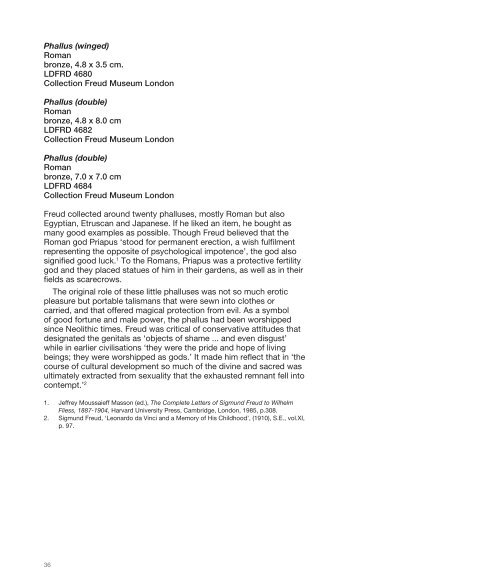sigmund freud's collection an archaeology of the mind
sigmund freud's collection an archaeology of the mind
sigmund freud's collection an archaeology of the mind
Create successful ePaper yourself
Turn your PDF publications into a flip-book with our unique Google optimized e-Paper software.
Phallus (winged)<br />
Rom<strong>an</strong><br />
bronze, 4.8 x 3.5 cm.<br />
LDFRD 4680<br />
Collection Freud Museum London<br />
Phallus (double)<br />
Rom<strong>an</strong><br />
bronze, 4.8 x 8.0 cm<br />
LDFRD 4682<br />
Collection Freud Museum London<br />
Phallus (double)<br />
Rom<strong>an</strong><br />
bronze, 7.0 x 7.0 cm<br />
LDFRD 4684<br />
Collection Freud Museum London<br />
Freud collected around twenty phalluses, mostly Rom<strong>an</strong> but also<br />
Egypti<strong>an</strong>, Etrusc<strong>an</strong> <strong>an</strong>d Jap<strong>an</strong>ese. If he liked <strong>an</strong> item, he bought as<br />
m<strong>an</strong>y good examples as possible. Though Freud believed that <strong>the</strong><br />
Rom<strong>an</strong> god Priapus ‘stood for perm<strong>an</strong>ent erection, a wish fulfi lment<br />
representing <strong>the</strong> opposite <strong>of</strong> psychological impotence’, <strong>the</strong> god also<br />
signifi ed good luck. 1 To <strong>the</strong> Rom<strong>an</strong>s, Priapus was a protective fertility<br />
god <strong>an</strong>d <strong>the</strong>y placed statues <strong>of</strong> him in <strong>the</strong>ir gardens, as well as in <strong>the</strong>ir<br />
fi elds as scarecrows.<br />
The original role <strong>of</strong> <strong>the</strong>se little phalluses was not so much erotic<br />
pleasure but portable talism<strong>an</strong>s that were sewn into clo<strong>the</strong>s or<br />
carried, <strong>an</strong>d that <strong>of</strong>fered magical protection from evil. As a symbol<br />
<strong>of</strong> good fortune <strong>an</strong>d male power, <strong>the</strong> phallus had been worshipped<br />
since Neolithic times. Freud was critical <strong>of</strong> conservative attitudes that<br />
designated <strong>the</strong> genitals as ‘objects <strong>of</strong> shame ... <strong>an</strong>d even disgust’<br />
while in earlier civilisations ‘<strong>the</strong>y were <strong>the</strong> pride <strong>an</strong>d hope <strong>of</strong> living<br />
beings; <strong>the</strong>y were worshipped as gods.’ It made him refl ect that in ‘<strong>the</strong><br />
course <strong>of</strong> cultural development so much <strong>of</strong> <strong>the</strong> divine <strong>an</strong>d sacred was<br />
ultimately extracted from sexuality that <strong>the</strong> exhausted remn<strong>an</strong>t fell into<br />
contempt.’ 2<br />
1. Jeffrey Moussaieff Masson (ed.), The Complete Letters <strong>of</strong> Sigmund Freud to Wilhelm<br />
Fliess, 1887-1904, Harvard University Press, Cambridge, London, 1985, p.308.<br />
2. Sigmund Freud, ‘Leonardo da Vinci <strong>an</strong>d a Memory <strong>of</strong> His Childhood’, (1910), S.E., vol.XI,<br />
p. 97.<br />
36

















